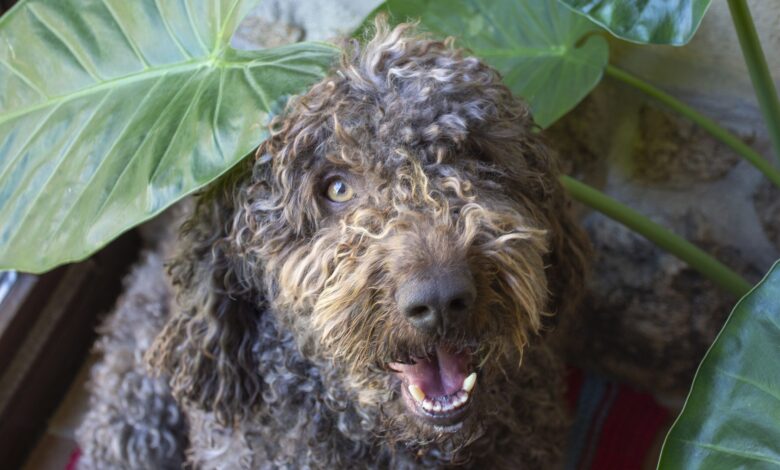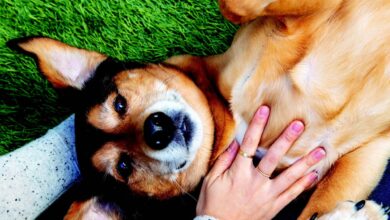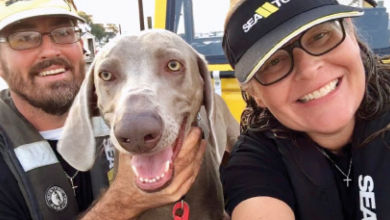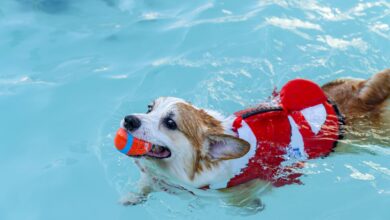Keep Up with the Spanish Water Dog Breed – Dogster

[ad_1]
The Spanish Water Dog was developed on the Iberian Peninsula (which covers Spain and Portugal) to hunt, help farmers, herd and assist fisherman. Although his name makes him sound like he’d belong in the Sporting Group (and indeed he does like both water and sports), the American Kennel Club placed him in the herding group because of his strong herding history and instincts. The breed was fully recognized by the AKC in 2015. The dog was ranked 145th in popularity in 2021 by the AKC.
How much does the Spanish Water Dog weigh?
Male Spanish Water Dogs weigh 40 to 49 pounds. Females weigh 31 to 40 pounds.
How long does the Spanish Water live?
They live for about 12 to 14 years. Health concerns are hip dysplasia, retinal atrophy and hypothyroidism.
What is the Spanish Water Dog’s activity level?
The SWD is not a couch potato by any stretch. A high-energy breed, the SWD has the capacity for lengthy, strenuous exercise. He makes a great companion for families who camp, run, hike, and enjoy water and shore activities. What equipment will you need? Plenty of retrieving toys.
Does the Spanish Water Dog like water?
Water and the SWD are a match. After all, the SWD in part was developed to help fishermen: The dogs would leap off piers and boats to retrieve overboard tackle, lines and stunned fish. Today he’s an enthusiastic swimmer and water retriever. His webbed toes facilitate his swimming, as does his body structure and coat. SWDs are usually strong swimmers, and playing fetch in the water is a great way to help them expend energy. Some SWD dogs have the capacity to dive to recover items down in the water.
The Spanish Water Dog and dog sports
Most SWDs delight in jumping into water, which leads to the Dock Diving sport option. In Dock Diving, dogs run the length of a dock and leap out into the water to retrieve a prized toy, in competition for height or distance.
Spanish Water Dogs are eager participants in non-water sports as well, including agility, obedience, flyball and herding. Many also revel in the sport of tracking, in which owners set a scent track for a dog to follow.
Does the Spanish Water Dog get along with others?
The SWD is a controlling herding breed, which means he may chase anyone (animal or human) he thinks is running amuck. The breed may try to control children’s yard play by chasing and circling, as he would do with disorderly stock. Children won’t likely appreciate this attention (perhaps the livestock don’t either, but them’s the breaks!), so SWD owners will want to curb this behavior early in puppyhood.
Training the Spanish Water Dog
While the Spanish Water Dog is intelligent, quick to learn, and willing to obey, he does have an independent side, and he’s got bossiness in his genes. When training a herding dog, owners do well to keep the dog’s natural herding instincts in mind. The breed was expected, with minimal training and human direction, to manage goats, sheep, cattle and pigs. The SWD puppy’s instinct to chase, boss, or nip to control, is more easily redirected if owners understand it as inborn working behavior, not willfulness, and certainly not aggression.
The Spanish Water Dog and strangers
Often suspicious of strangers, SWDs bond closely with family. Their protective instincts make them self-appointed guardians to their people and property. Although ideally not timid or shy, the SWD is yet naturally wary of strangers. Pups need to be socialized extensively, to learn to discern friend from foe, and to accept strangers into the home.
Spanish Water Dog’s coat and grooming
The SWD’s coloring may be solid (in shades of black, brown, beige or white) or parti-color where the second color is white. He is single coated and curly — a low-shedding breed. So what’s the story behind the distinctively curly coat? The coat was an adaptation to the weather of the breed’s native country of Spain. The coat adapted to the variation of humidity and drought. The curly coat may form cords when long.
When SWDs are competing in the show ring, show coats aren’t brushed or combed. Non-show dogs can be clipped as often as owners prefer, with some owners choosing to let it grow for many months. Traditionally the Spanish Water Dog was sheared one time per year (with the sheep), the same length all over the body.
The SWD’s beautiful curls need some specific attention. But surprisingly, no brushing or blowing needed. When washing and drying the curls, owners shouldn’t rub or scrub the dog’s hair. Instead, shampoo should be squeezed, not rubbed, through the hair. Curls can be dried by blotting the moisture out of the coat, again focusing on avoiding rubbing.
Is the Spanish Water Dog hypoallergenic?
Although the SWD is a single coated breed that sheds less than most breeds, he isn’t (nor is there such a thing as) a “hypoallergenic” dog breed. Even with his low-shedding coat, allergic individuals may react to his hair, his dander and his saliva.
The SWD does shed notably less than many dogs, which can be a blessing for families wanting their homes as hair-free as possible.
A working history of the Spanish Water Dog
The medium sized ancestors of the SWD have been working with gusto in the Spanish countryside for some 800 years. Developed as an all-around farm dog with resilient herding instincts, the SWD gathered sheep, goat or cattle. He also assisted fishermen, retrieved water fowl and protected the homestead.
The breed’s exact early origins are contested by experts. What is agreed upon is that the breed was developed in Spain centuries ago for all his jobs, including hunting, water work, herding, home guarding and, of course, companionship.
In the central and southern regions of Spain, the dogs primarily drove herds of sheep, cows, pigs and goats to seasonal pastures. They also helped hunt fowl and small game. In the northern coastal regions, Spanish Water Dogs retrieved fish and tackle from boats and swimming lines. The northern dogs probably also hunted, especially during the off-season. Spanish Water Dogs primarily were owned by less-wealthy folk, who certainly couldn’t afford dogs specialized in only one task.
Early SWDs may also have worked in Spanish mines to defend mule transports, guard against thieves, and keep rats at bay in the mines. The dogs’ woolly coat helped protect them in the hot and humid mines.
In more modern times, Spanish Water Dogs are no longer needed for much of their early work. While SWDs can be found still herding in the southern regions of Spain, the breed has willingly taken on new jobs, such as search and rescue, cadaver search, bomb detection and drug detection.
Spain only has two AKC breeds that begin with the country’s name: the Spanish Water Dog and the Spanish Mastiff. Historians surmise that the two breeds may have worked together on the annual migration of animals to and from seasonal pastures. The SWD herded and controlled the animals; the Spanish Mastiff (some 140 to 200 pounds) was a formidable livestock guardian.
[ad_2]
Source link






